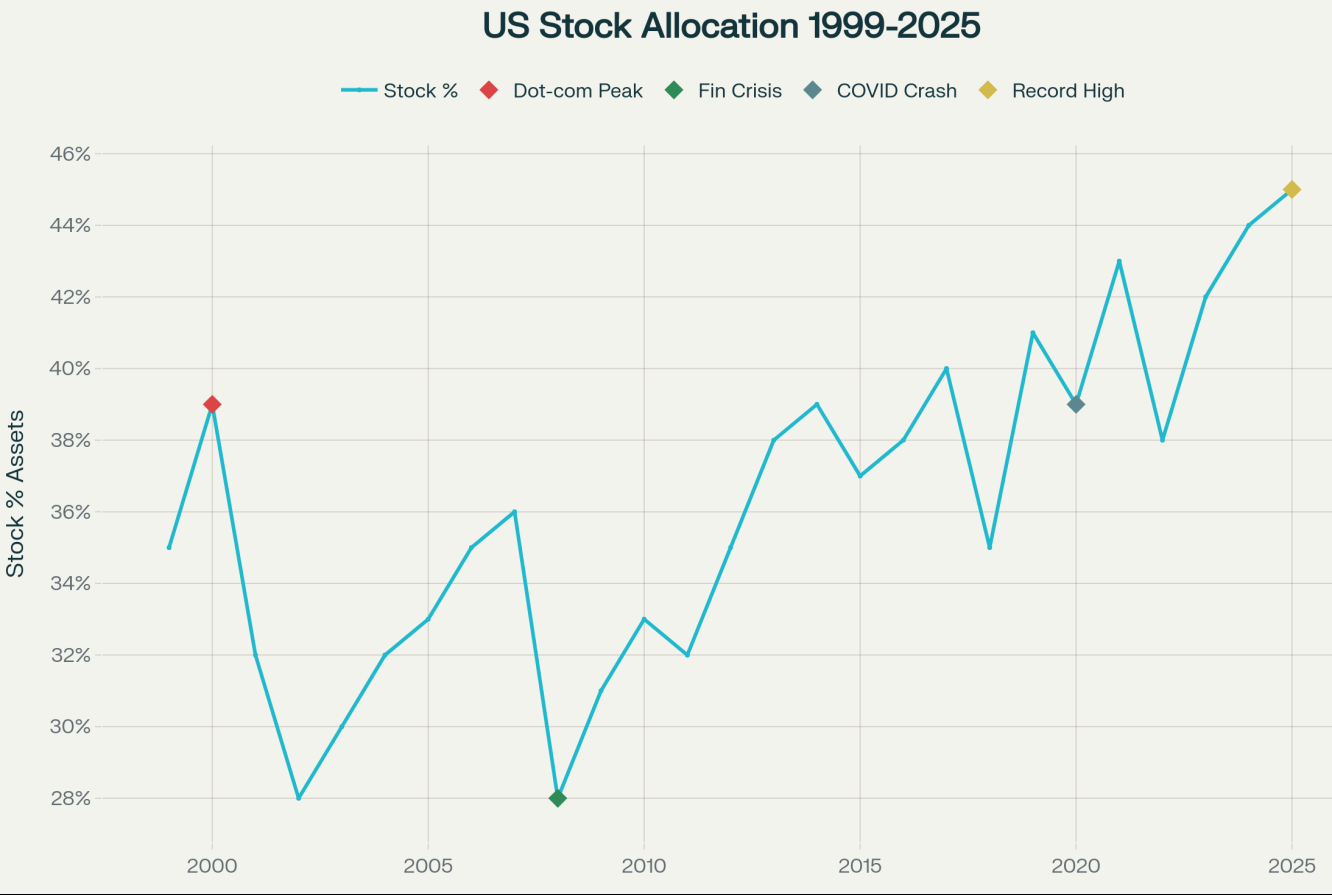TSX jumps amid Fed rate cut hopes, ongoing U.S. government shutdown
US household wealth reached $176.3 trillion in the second quarter, but underlying data is raising concerns among market analysts. Some experts point to trends in portfolio allocations that could signal increased financial risk.
Americans now have 45% of their financial assets parked in stocks. That’s not just a record – it’s the highest level ever recorded, surpassing even the dangerous concentrations we saw before the dot-com implosion. And honestly? It’s starting to feel like we’re watching the same movie again, just with different actors.
The Magnificent Seven Problem Nobody Wants to Talk About
Here’s where things get interesting – and by interesting, I mean potentially catastrophic. The market’s become so concentrated that just seven companies now make up 34% of the entire S&P 500. Microsoft, Apple, Amazon, Alphabet, Meta, Nvidia, Tesla – you know the names. The problem is, these Magnificent Seven have been carrying the whole show, accounting for 41% of the index’s gains this year.
Goldman Sachs has released research that should terrify anyone paying attention. When you factor in market concentration as a distinct variable, their model suggests the S&P 500 might deliver just 3% annualized returns over the next decade – compared to the historical 11%. That’s not a haircut, that’s a scalping.
Back in 2000, the top ten stocks hit 25% of market cap, and we all know how that ended. Today? We’re sitting at 36%. The math here isn’t complicated – it’s just uncomfortable.
When the Wealthy Stop Spending, We All Feel It
The really wild part – and this is where it gets economically dangerous – is how dependent our entire consumer engine has become on wealthy stockholders. The top 10% of earners now drive 49.2% of all consumer spending, the highest share since we started tracking this data in 1989.
Think about that for a second. When these portfolios get cut in half (and they will, eventually), it’s not just paper losses we’re talking about. It’s the consumption that’s been propping up this entire recovery. These folks have been spending like the market will never go down again, and why wouldn’t they? Their net worth keeps hitting new records every quarter.
But here’s the real gut punch: stock market wealth can vanish almost instantly, unlike housing wealth, which tends to erode slowly. A downturn in real estate is a gradual process, but when stocks tank, entire fortunes can be wiped out in a matter of days. With households now holding equities at a record 30% of their total net worth, we’re staring down the barrel of a wealth shock that could make 2008 look mild by comparison.
The Fed’s Difficult Position
Jerome Powell’s been talking about this for months, making vague references to "unusually large amounts of economic activity" from AI buildout. Translation: he knows this looks unsustainable but can’t exactly come out and say the market’s in bubble territory.
The Fed’s own research shows that wealth heterogeneity now explains 88.7% of slow recovery patterns. When wealth gets this concentrated among high earners, the economy becomes incredibly fragile to asset price shocks. We’re basically running a consumer economy on portfolio gains – what could go wrong?
History Rhymes, Even When We Don’t Want It To
Anyone who’s studied market history has seen this script before. In 1999, there were endless reasons why "this time was different." The internet was going to change everything. Valuations supposedly didn’t matter because a new paradigm had arrived.
Today it’s AI. And sure, artificial intelligence will probably change the world – eventually. But when Howard Marks from Oaktree Capital says we’re "in the early days" of a bubble, you should listen. This guy called the dot-com crash and the financial crisis. He’s not exactly known for crying wolf.
The behavioral signs are all there. Retail investor participation has doubled to 18% of equity volume. Foreign investors are holding record levels of U.S. financial assets. Options activity is through the roof. IPOs are popping 80% on their first day.
Sound familiar?
The VIXY Play: Betting on Fear When Everyone’s Greedy
So what’s an investor supposed to do? Well, if you believe Warren Buffett’s old advice about being "fearful when others are greedy," there’s actually a pretty clean way to position for this.
VIXY – the ProShares VIX Short-Term Futures ETF – is basically a bet that volatility will spike when this whole house of cards starts wobbling. Right now, with the VIX sitting around 14-18, you’re getting cheap insurance on what could be a spectacular unwind.
When COVID hit and everyone realized how exposed they were, VIXY shot up over 1000% while the S&P 500 dropped 34%. During the 2008 crisis, the VIX spiked over 80. If – and when – this concentration unwinds, volatility is going to explode first and ask questions later.
The beauty of VIXY over something like inverse ETFs is that you’re not fighting daily decay and compounding issues. You’re just buying market fear, and right now, fear is pretty cheap.

